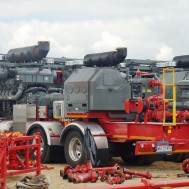In order to achieve successful hydraulic applications, seals must be engineered using the right material and design. Many applications require specific seal characteristics to effectively get the job done, like fluid pressure range, temperature range, size and compatibility with certain fluids.
Since each hydraulic application uses different chemicals, temperature and pressure, it is important that the right material and type of seal are chosen to avoid seal failure and any catastrophic system failures. Here are a few factors to keep in mind to avoid these issues in your hydraulic application:
Make sure you choose a material that can handle extreme heat.
Every rubber compound is different. Some offer excellent heat resistance while others do not. Since rubber seals can be exposed to extreme heat in hydraulic applications, it’s important to be aware of the limitations each materials face and choose a material that can handle specific temperatures.
Heat can harden elastomers, significantly reducing the lifespan of the seal. When the elastomers harden, the seal begins to degrade, become brittle and eventually fall apart. Degraded materials can break off into the hydraulic system, causing contamination. In order to avoid further complications in your hydraulic application, it is important to research which materials offer the heat resistance you are looking for. Apple Rubber’s material selection guide is a great place to start.
Be aware of pressure tolerance.
In hydraulic applications, seals can be exposed to large amounts of pressure. Without proper design, the seal can become overstressed, causing it to crack or even fail completely. Seal failure can be an extreme danger to hydraulic systems and employees, so paying attention to material limitations is critical.
Like temperature, pressure tolerance is specific to each type of rubber material. Before choosing a seal for your hydraulic application, make sure you choose a material that can handle the specified requirements.
Most hydraulic system failures are a result of contamination.
Contamination can cause major consequences if not properly controlled, including internal leakage and lowered efficiency of hydraulic pumps, motors and cylinders. For seals, lack of contamination control can result in degradation, transient failures or even catastrophic system failures.
In order to avoid contamination, always make sure you have new oil, proper filtration systems in place and management to monitor contamination levels. It’s important to know the environment you’re working in and what your application needs are. Make sure you select the proper fluid for your system, handle the fluid properly and schedule routine maintenance for all hydraulic systems. By following these steps, you can take control of contamination and prevent major devastations in your equipment.
